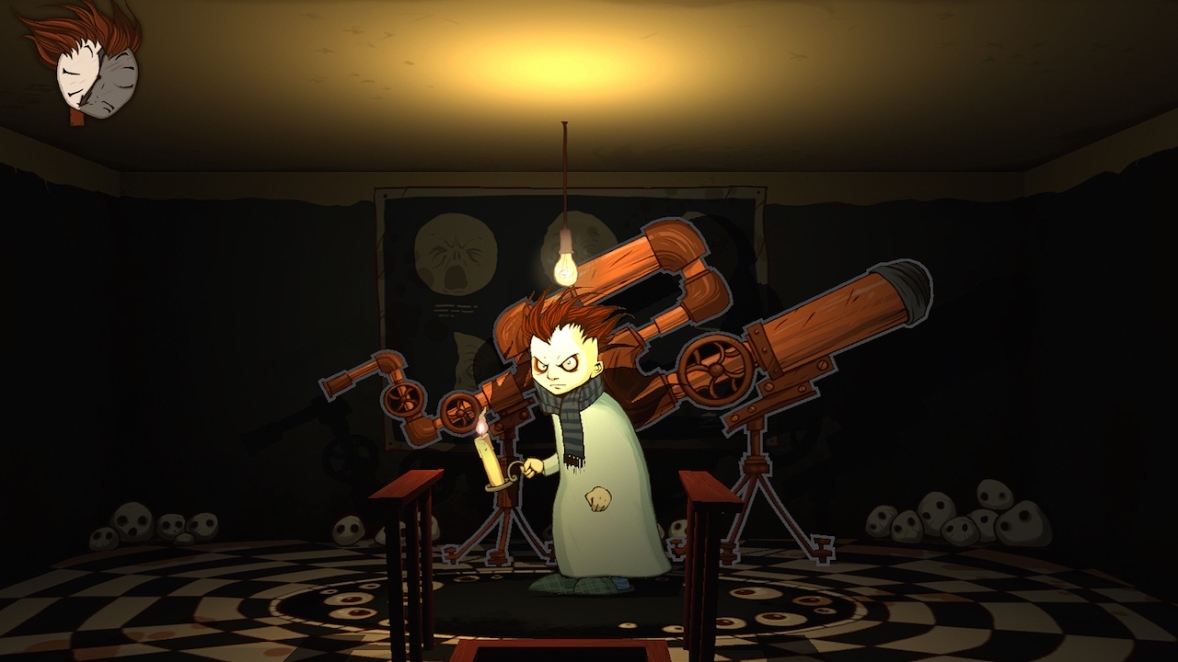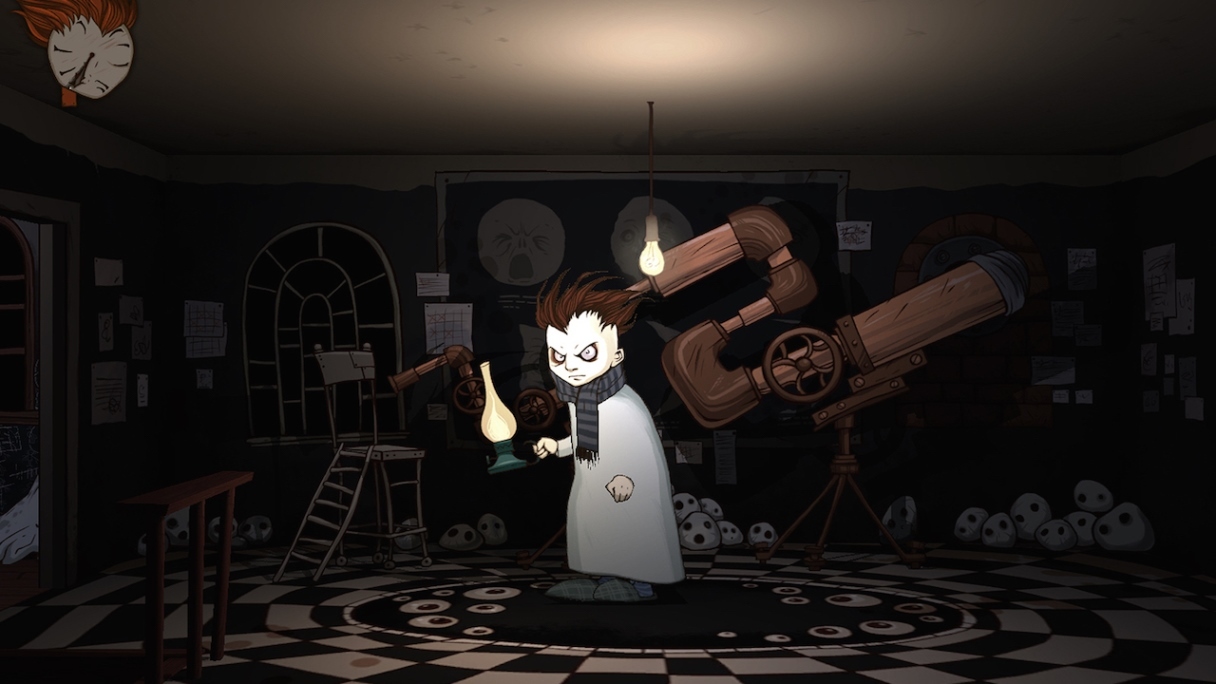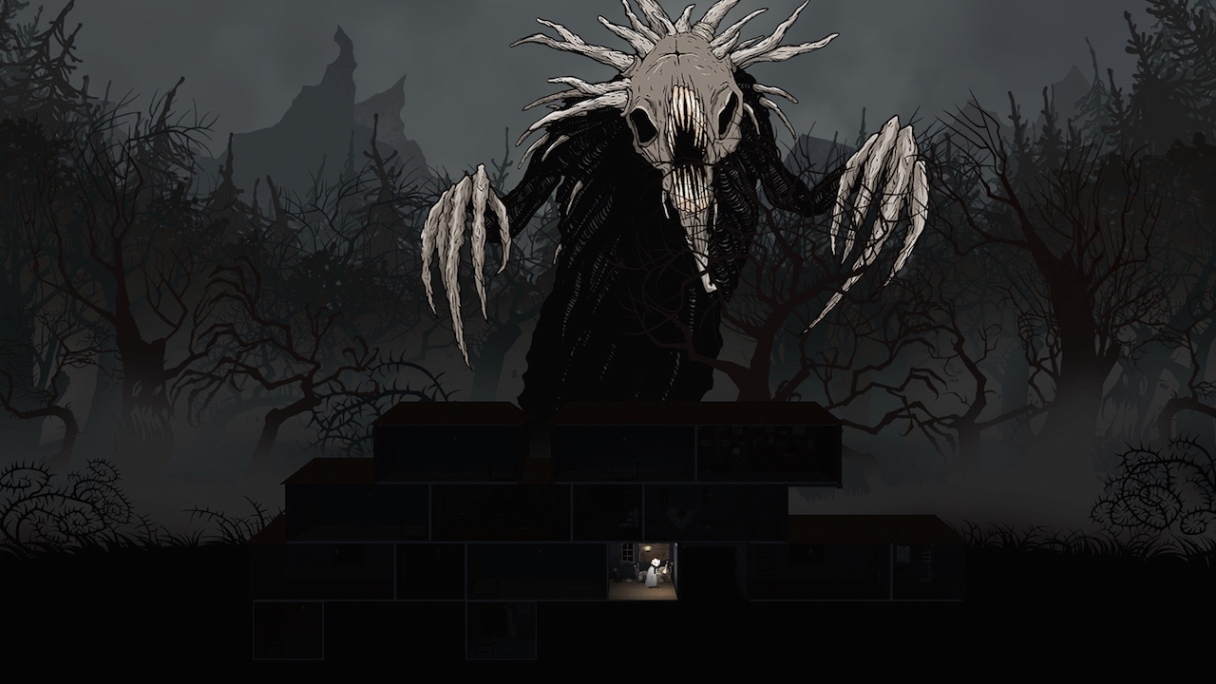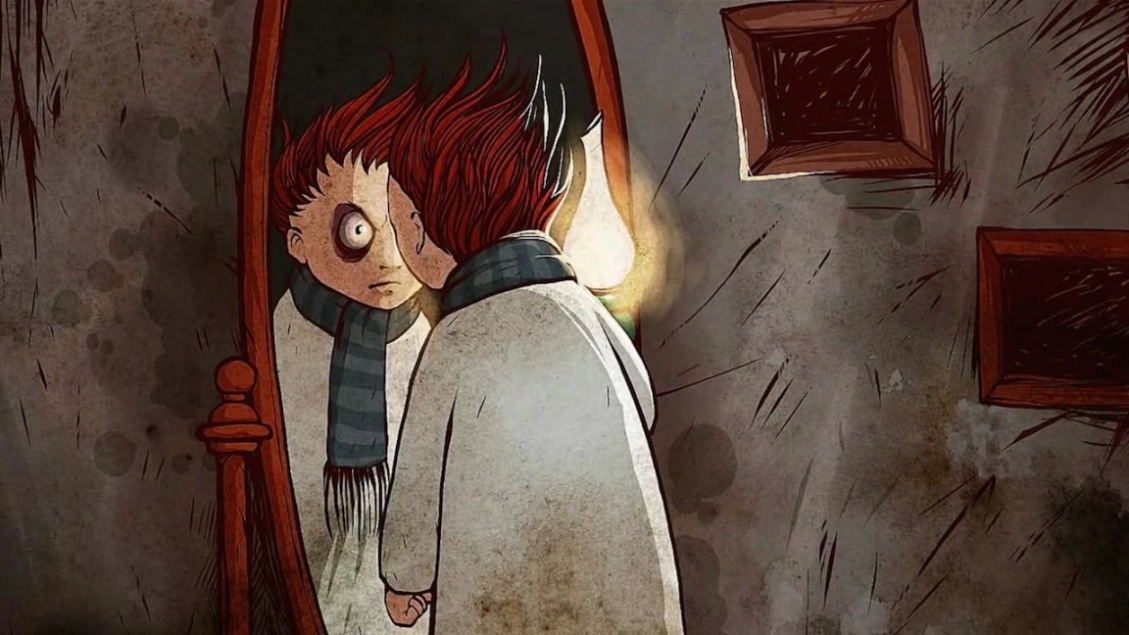“What you see before you is not exactly what one would call “a game”. It’s more like an interactive meditation…” And the award for the most pretentious opening to a video game goes to Knock-knock, an unusual survival horror game which was originally released on PC in 2013 and has recently been re-released for the PS4. Essentially Knock-knock is a haunted house game in which you play as an unnamed protagonist whose aim is to survive several nights within his ghost invested home.
The back story, like many of the game’s mechanics, is shrouded in mystery. Any back story behind the game is either told via the protagonist himself or from strange notes that can be found scattered around the house. The protagonist spends a lot of time talking throughout this game, although he doesn’t actually tell you very much. Some of this dialogue will make sense, however most of his statements will either be up for interpretation or are designed to confuse and bewilder.
What can be determined is that the protagonist is a scientist. He lives alone in a large house / laboratory in the middle of a forest. His father and grandfather were both scientists before him, all of which used this location to conduct research into the atmosphere and surrounding nature. Recently he has been struggling with sleep and has convinced himself that he is suffering from delusions. For example, in one segment he talks about how he cannot report on anomalies that he can’t explain scientifically, such as new stars appearing in the sky.
Here’s where the confusion begins. The goal of the game is for the protagonist to survive through the night until sunrise. There are 3 repeating phases to the gameplay which I refer to as ‘the overworld’, ‘the outside’ and ‘the nightmares’. The overworld is essentially an interactive cutscene, and this is the part that the protagonist has to survive through to beat the game. In this segment the protagonist is safe and alone in his house, however time does not move naturally. Rather than be able to wait until sunrise, the protagonist can wind a segment of time forward by finding a clock which will appear somewhere randomly in the house. During this segment the protagonist will often speak to the player, conveying his thoughts and feelings at the time. Once he’s moved a segment of time forward he cannot proceed any further without going through the phase cycle. You have to take the protagonist outside of the house to inspect the forest, and on returning to the house you then have to endure the ‘nightmare’ segment which is where the main gameplay takes place.
The reason I say “Here’s where the confusion begins” is because the nightmare phases themselves involve surviving a night in the haunted house. In order for time to pass in the overworld, you have to survive many nights in randomly generated houses which resemble the overworld house, but can be structured very differently. The reason I refer to these phases as ‘nightmares’ is because I’m assuming that these phases are what the protagonist is dreaming about, and that the overworld is his real life experience of interrupted sleep. However, this is only my interpretation of what’s going on. The plot itself is very abstract in that regard.
A few of the game’s mechanics are explained in the first nightmare section, however you are left to fend for yourself from very early on. For example, the protagonist will explain how to fix light bulbs, but it’s up to the player to decide when it’s a good idea to do this and when it’s best to keep the lights off. When a nightmare section begins you’ll have a very short period of time to explore nearby rooms. Since these houses are generated randomly you’ll never know where you can run and hide to until you have done some exploring first. During this period there are useful things to do such as unlock doors, fix light bulbs, discover furniture to hind behind, and maybe even find a few clocks that can move time forward by a few minutes. Each nightmare lasts from around 5 to 10 minutes, so being able to shave a few minutes off is very handy.
After a few minutes a rip will appear somewhere in the house, which will allow ghosts or ‘guests’ to roam free. Some of these ghosts are ‘static’ while others are ‘stalkers’. Static ghosts will appear randomly in dark rooms and will stand in the one position for a short time. They will only hurt you if you either walk into them or switch a light on in the room they’re standing in. Doing so will rewind a period of time and in some cases teleport you to another room in the house. Static ghosts are relatively harmless although they can appear in awkward places such as doorways or corridors.
Stalkers are a lot more sinister. They can move freely around the house and can even move through doors and walls. This is why you want to unlock as many doors as possible in advance as each door can take few seconds to open and you do not want to waste time if you’re being chased. If you get caught by a stalker it will set you back by a large chunk of time and, if you haven’t survived for long enough, can even restart the phase from the beginning. If you’re running away from a stalker and can’t shake him off then you can hide behind the furniture that you have discovered, although hiding in this way will slowly make time travel backwards so it’s not something you want to do too often or for very long.
If a rip appears in the house you will be notified as to where it is, which will give you some idea of where the ghost’s presence is the strongest. If you’re feeling brave you can tackle the problem head on by entering the room with the rip and switching the lights on. This will block the rip up and earn you a short reprieve until the next rip appears. If you’re not feeling brave you can find a few hiding places as far away from the rip as you can get and try to hold your own from there.
As these nights go by, the game will eventually get harder. The houses will get bigger, rips will appear more frequently and different types of ghosts will appear. For the first six nights it isn’t too damaging if you make mistakes, however after night six a fail state is introduced into the game. On starting night seven you’ll notice a streak of lighting across the top of the screen. This is your sanity meter and it will slowly deplete as you play. By getting caught by ghosts you’ll end up spending longer in the nightmares and as a result your sanity will shrink even lower. If your sanity depletes completely at any point you will not be able to make it to the end of the game, forcing you to restart.
Personally I think this is a bit harsh since this is an all or nothing arrangement. There’s no way of regaining sanity in as much as there are no ‘extra lives’ or ‘mental health kits’ to pick up along the way. It’s just a case of ‘survive until the end’ or ‘go insane and start again’. However, this game isn’t particularly long with most playthroughs lasting around a couple of hours, give or take.
As far as the game’s presentation goes it does look really good. This game was built-in Unity, and is played in a cartoon like 3D environment with lots of strong dynamic lighting. Although the game’s environment is 3D, it’s played like a pretty basic 2D platformer where the character can walk left or right and climb ladders. All the features such as the main character, the ghosts and environment elements are all beautiful animated and appear as flat cartoon drawings, reminiscent of a Paper Mario style of game. The game’s use of light is incredible and really helps create a haunted atmosphere. The main character carries a small candle which will grant him limited visibility in the dark. This can be creepy when you’re shuffling down a corridor and notice an obscure static ghost right in front of you. In contrast, whenever you switch on bright lights they can cast detailed shadows which can be mistaken ghostly apparitions in the heat of the moment.
There isn’t a great deal of music in the game. There’s an occasional flourish here and there, mainly during cut scenes or when you discover something mysterious. However, for the majority of the time you’ll be playing amongst either silence or sound effects. The sound effects here are very much the sort of stock sounds you’d expect to find on a Halloween themed effect CD. Lighting strikes, owls hooting, leaves being crushed under foot. All very cliché stuff but it’s not bad and it does the job. The game does however make clever use of the control pad’s speaker. By playing different sounds through your control, in addition to the sounds coming through your TV, the game immerses you into the character’s shoes. What could be creepier than hearing footsteps on the TV and then suddenly a voice speaks to you through your control pad?
Speaking of controls, they are very simple and user-friendly. Since there isn’t a great deal of things for the character to interact with, the controls are boiled down to use of the D-pad for movement and two face buttons for interaction. One operates lights and doors while the other winds clocks forward. You can also hold down a shoulder button to zoom the camera out and get a better look at the whole house which can be very helpful.
Although the basic mechanics of this game are quite easy to master, such as running and hiding from ghosts, it also creates a great deal of confusion. In an attempt to create a mysterious and subjective plot, I feel that developers have unintentionally created a subjective game on the whole. I understood that I had to survive until morning, but should I try to defend myself in one room or should I attempt to explore the whole house? If I don’t explore around will I miss something? If I’m safe when the sun rises does that mean that the ghosts only appear in the dark? Is the aim to try to turn every light in the house on or will that just alert the ghosts as to where I am? Does turning the lights on make time go faster? What’s the point of exploring the forest outside? Should I be trying to heal up the rips, enter them, or avoid them completely? I guess part of the appeal that this game offers is trial and error, but this can be frustrating when you’re trying to survive and you end up getting penalised by your curiosity.
Without spoiling too much, this game does have multiple endings. There is a bit more to the game than simply surviving as there are also some mysteries to discover, however I do think the way that this game is structured and the methods used to hide these mysteries are all a bit weak.
From a technical standpoint the game is stable for the most part. I noticed a few graphical and sound glitches during the game’s opening cut scene, which happened every time I started a new game so this wasn’t a one-off issue. However, there were no game breaking bugs or crashes to speak of. There were a few questionable design choices in how the game is structured. It always looked odd to me how the main character can reach up to fix the lights in a room, despite the fact that he could be stood six feet away from them. He just reaches up into thin air and starts fiddling around with his hands, as such he can fix the lights from anywhere providing that he’s standing in the same room.
One thing that I found annoying is that after I lost all of my sanity during my first playthrough I was given the option to continue. However, when I returned to the game I still had no sanity left, so as soon as I finished the cutscene the ‘Game Over’ screen appeared again. I was caught in a never-ending loop until I restarted the game. If I’m in a position where it’s impossible for me to continue why am I being given the option to continue? Surely it should just say ‘Game Over’ and start me back from the beginning!

In conclusion I think Knock-knock had all the makings of a good horror game, but missed the target in too many areas. For a start I think the game has a bit too much fat on it which could have done with trimming. I think splitting each stage into three phases was confusing and completely unnecessary. The first two phases add practically nothing to the game, only a bit of dialogue and an opportunity to discover one of the mysteries. These could have easily been included in the nightmare phases and would have helped to flesh these segments out a bit more. Additionally I think a lot of the main character’s waffly dialogue should have either been cut or rewritten to be a bit more helpful. It reminded me of the town folk in ‘Castlevania 2: Simon’s Quest’ in regards to how useful it was.
What’s interesting about Knock-knock is that it does predate a very good game which shares a lot in common with it. ‘Five Nights at Freddy’s’, the popular indie PC game, is also a horror game which is made up of simple mechanics to master in order to survive, has an overarching mystery to solve in the background, and on the whole does a much better job of it. Each night of FNAF consists of nothing but survival gameplay with any story dialogue or minigame mysteries embedded within the gameplay itself. In addition, the back story is a lot more interesting and the horror experience is far more intense.
Since Knock-knock came first I have to give it credit for trying to combine simple gameplay mechanics with a horror story. I think upon this as the beta ‘Five Nights at Freddy’s’ and would not be surprised if ‘Knock Knock’ played some part in its inspiration. However, as it stands it’s a bit of a mess. There is some fun to be had here and I’ll more than likely try it again at some point in the future, but it’s nothing amazing.

REVIEW CODE: A complimentary Sony Playstation 4 code was provided to Bonus Stage for this review. Please send all review code enquiries to press@4gn.co.uk.
Subscribe to our mailing list
Get the latest game reviews, news, features, and more straight to your inbox
Thank you for subscribing to Bonus Stage.
Something went wrong.
-
Gameplay - /10
0/10
-
Graphics - /10
0/10
-
Sound - /10
0/10
-
Replay Value - /10
0/10








